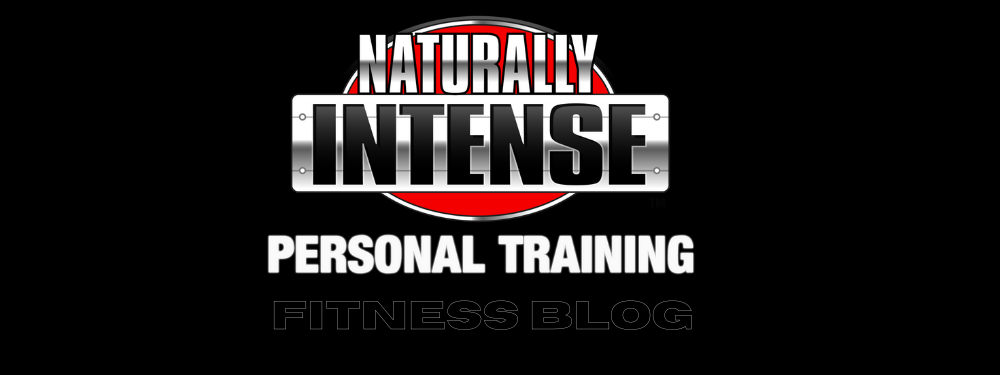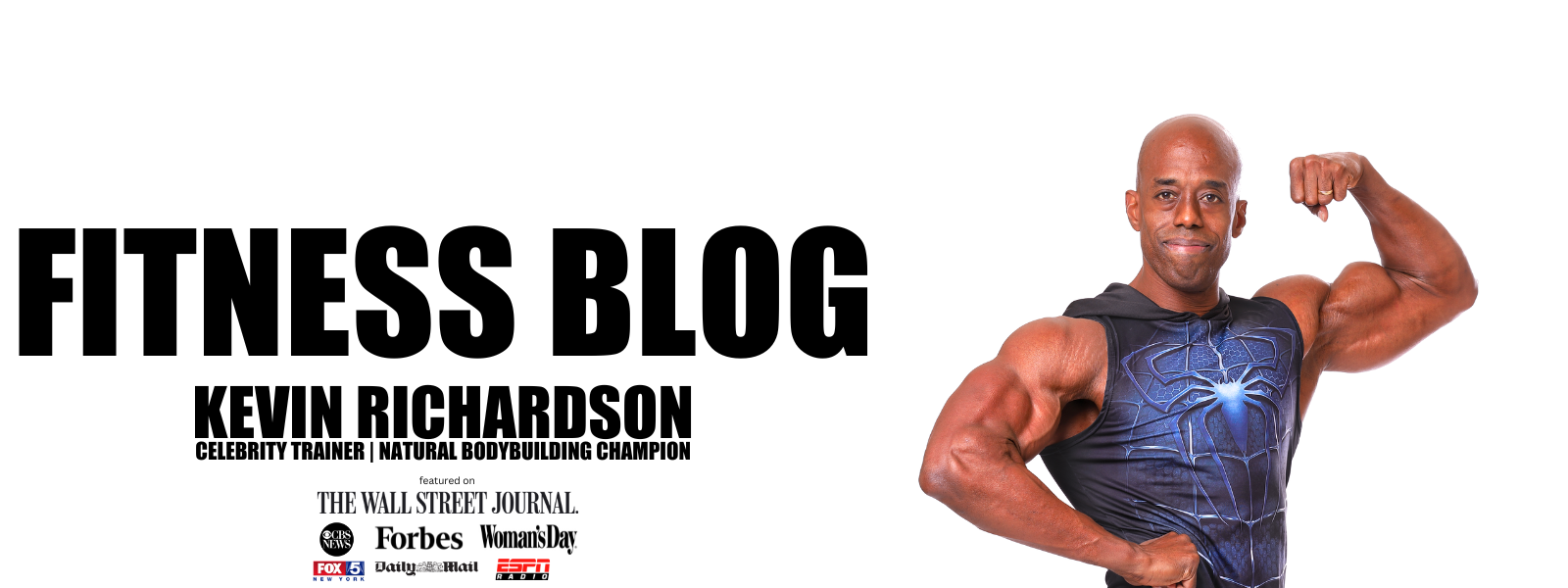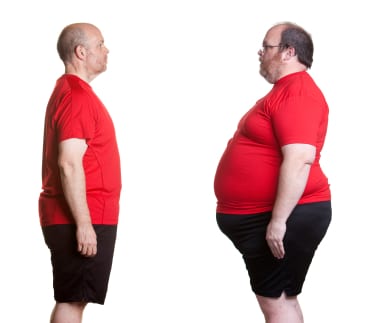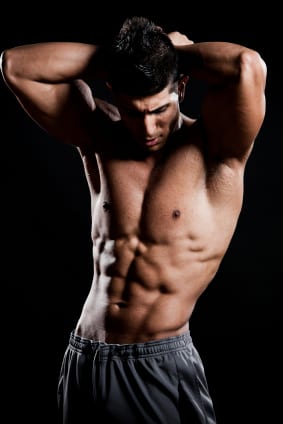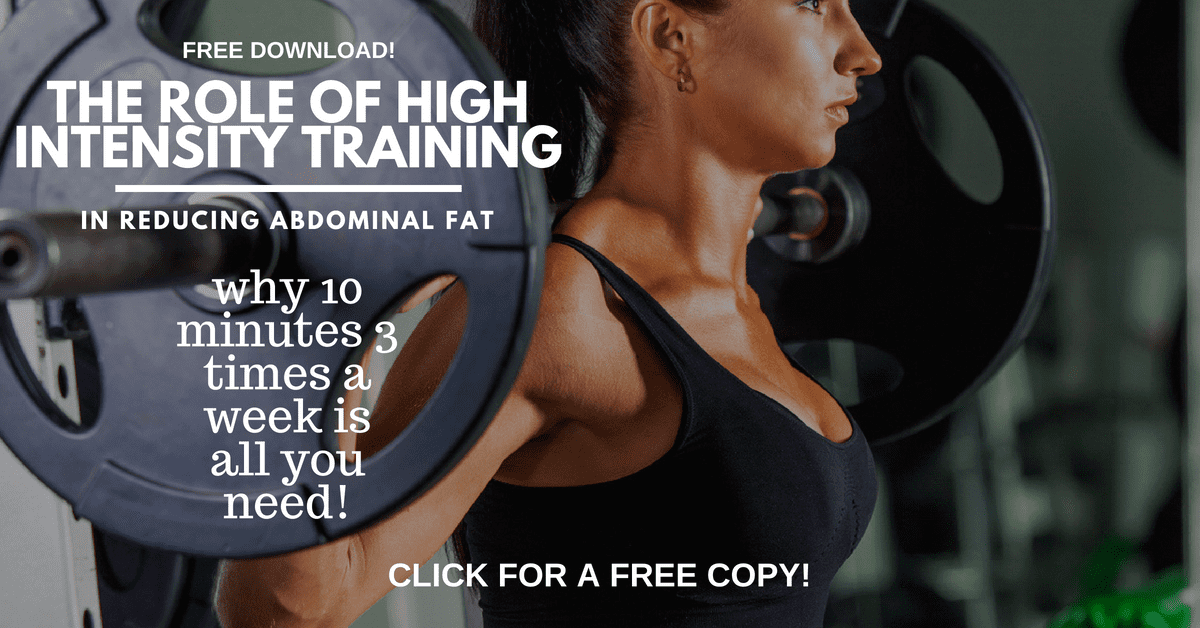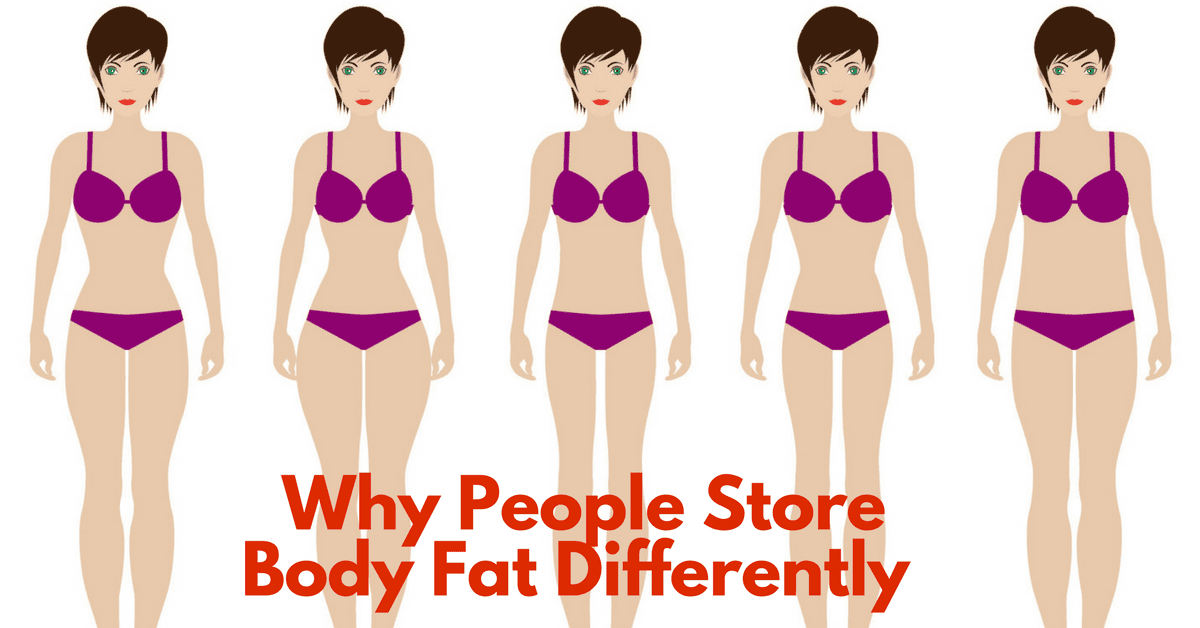
Why People Store Fat In Different Parts Of Their Body
Why do people store fat in different places? One of the most frustrating aspects of weight loss is that very often the areas where you store the most fat seem to be the hardest parts to trim down. Pockets of fat stored in just the wrong places that stubbornly resist all but the most persistent of attempts to get rid of them and obscure the muscle definition you work so hard to attain! Attempts that can often take months if not years, while other people just don’t seem to have any fat whatsoever in your problem areas where you store fat. Globally at least 300 million people are what would be categorized as clinically obese[1] and just about one in three Americans are over their ideal weight, [2] but even those who are in relatively good shape and some who you might characterize as skinny, still have problem areas in the form of adipose tissue behind their arms, in their lower abdominal region, behind their legs, around their waist or in the buttocks that are enough to make them very much concerned about how they look. In fact almost no one is immune to this problem of having an area of stored fat that doesn’t want to go away in spite of hours of cardio and calorie restricted diets. It’s a demoralizing dilemma, especially among women, and one persuades otherwise level headed and rational thinking individuals to spend their hard earned cash on everything from vibrating machines, cellulite massages and spot reduction creams. All in the hope of ridding those problem areas of adipose tissue. In this article we will explore how and why people hold fat on their bodies in such different places and different ways and take a look at how our environment, diet, genetics and even race can play a major role in how and where we gain and store body fat. Thanks as always for reading my articles and do be sure to share them with anyone who you think might stand to benefit.
Why People Store Fat In Different Parts Of Their Body: Understanding Phenotypes
Obesity is not a uniform occurrence as it can manifest in very different ways. You may have noticed at the gym or at the beach that people who are overweight don’t all look the same, nor do they all carry excess fat in the same places. Women typically store fat very differently from the way men store fat- but even among the sexes there can be significant differences. Just as there are different body types, there are also different ways in which humans store fat. One of the major findings of modern obesity research is that certain forms of obesity are associated with higher incidences of metabolic disease and higher mortality rates, while others don’t have the same health risk associations.[4] To distinguish between the different categories or phenotypes of obesity, researchers defined four main manifestations brought about by combinations of environmental pressures (a fancy term for diet and activity levels) and genetics. [5, 13, 14] The four phenotypes describing how people store fat differently on their bodies are:
- Excess body fat evenly distributed throughout the body
- Excess subcutaneous fat in the trunk and abdominal area (Android/male obesity)
- Excess subcutaneous fat in the trunk and or gluteal and femoral area (Gynoid/female obesity)
- Excess subcutaneous fat in the abdominal area (Abdominal visceral obesity) [5]
Even Body Fat Distribution
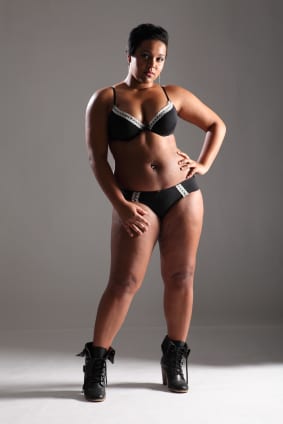
Like the somatypes used to categorize body types, (mesomorph, ectomorph and endomorph), these phenotypes are by no means absolute and individuals can have tendencies of more than one category of fat distribution.[5] The first phenotype is easily recognizable among those who have even distributions of adipose tissue throughout their body without noticeable accumulations in any one area. The lack of any one outstanding area of fat makes people with this form of fat distribution appear to not be carrying much excess body fat at all and many individuals of normal to low body weight can fall into this category. Popular social media personalities, most actors and actresses, and those who tend to do well in physique oriented competitions, fitness and bikini modeling fall into this category as they seldom have any one part of their body that holds more fat than another and they tend to be able to lose fat a bit more uniformly as well when dieting and exercising. Plus sized models are also good examples as while they may be overweight all excess fat is proportionately distributed.
Fashion and runway models are also usually in this category as they tend to have relatively high body fat and little lean muscle mass, but are skinny nonetheless, (the so called “skinny-fat” syndrome.) Unfortunately, many in this phenotype take little heed of their excess fat stores since the relatively even distribution can create the illusion that they are in good shape while over time they suffer the same health problems as those who are noticeably overweight, as you don’t need to have a large belly or noticeable pockets of adipose tissue to be at risk for metabolic disease. (4)
In fact this misunderstanding is the reason why so many individuals of normal weight have high rates of undiagnosed type 2 diabetes. Society may place a premium on being skinny but it isn’t necessarily an indicator of good health. [11] In fact all the research has conclusively demonstrated that health risks are more directly correlated to what you can do than what you look like. A reality that many overweight individuals who are physically fit need to embrace instead of attempting to conform to a rather superficial societal ideal. (See my article on Why Being Skinny Doesn’t Mean Being Healthy) With age however, this form of excess body fat becomes less common as diet, hormones, genetics and external factors like stress tend to manifest more localized fat distribution if there is no intervention in the form of a regulated diet and or regular exercise. As a result most people complain about getting fat as they get older not realizing that they may have had a high body fat percentage all along, but as the years went by and they got fatter the places where fat is stored becomes more concentrated and thus more noticeable. Genetics play a major role in this form of fat storage as some people maintain relatively high body fat levels all their lives in spite of low activity and unchecked diet without having a pronounced amount of fat in any one part of their body. However, as we mentioned earlier- it does not necessarily mean a better health, as dangerous visceral abdominal fat accumulations may be high but simply not to the extent where it is cosmetically noticeable.[4]
Why People Store Fat In Different Parts Of Their Body: Upper Body Android (Male) Obesity
Android obesity is characterized by excess body fat in the abdominal and trunk areas- but is not limited only to men.
Upper body or android obesity is more common in males than in females and is a fat storage phenotypes that tends to occur with advancing age.[5] This is an example of what is often termed sex specific fat and is characterized in males as relatively low body fat stored in the lower body but with a disproportionate amount of fat stored in the abdominal region (creating the classic ‘gut’ or ‘beer belly’) and or upper body truncal areas. While android obesity is often thought to be a male phenomenon, (which you would easily think given the name) this is quite often not the case. Females also exhibit android obesity, most often after menopause when estrogen levels begin to drop off. Android obesity is also associated with individuals (male and female) who are exposed to chronic stress. Our internal response to long term or prolonged periods of stress plays a key role in where body fat is stored on our bodies, regardless of gender. To that effect, women who have higher than normal levels of the stress hormone, cortisol, tend to have higher incidences of android type fat storage. [4, 12, 13, 14]. Women with above average levels of androgens also exhibit android obesity [5] and it is interesting to note that the shift in natural fat storage in men away from the lower body (especially the gluteo-femoral regions) caused in part by the action of the male hormone testosterone, is one reason why some women use steroids. Not for increased bulk, but for purposes of rapidly leaning out parts of the body that are especially resistant to fat loss in the female body. A practice that is sadly popular among many female fitness and physique athletes, but it is a short cut that comes with potentially harmful side effects. All the while similar results can be achieved safely and naturally in women through proper nutrition and exercise- but over a longer period of time.
Why People Store Fat In Different Parts Of Their Body: Lower Body Gynoid (Female) Obesity
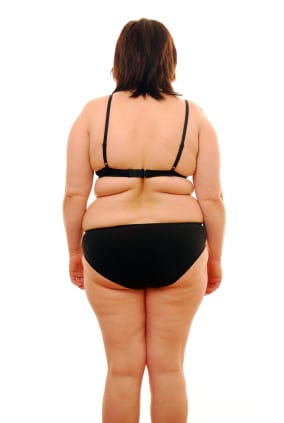 Gynoid or female obesity is the second so called sex specific fat accumulation categorization (though it should be noted that fat distribution is not necessarily always gender specific. Gynoid obesity manifests itself in very specific ways- fat is stored in the hip, thigh and buttocks in addition to the lower abdominal area and above the triceps muscles in the back of the upper arms. [5,6] Gynoid obesity is associated with a lesser risk of potential health complications than android obesity, as higher fat concentrations in the abdominal area is a strong indicator of increased risk of cardiovascular and inflammation related disease in overweight adults. [7,8] In spite of the lower health risks that this form of obesity confers, for many it is the most perplexing as adipose tissue in the leg and buttock region is indeed far more resistant to fat mobilization than fat found in the abdominal area- which is another reason men appear to lose weight faster than women (though higher muscle mass and consequently greater metabolic rates are factors as well).
Gynoid or female obesity is the second so called sex specific fat accumulation categorization (though it should be noted that fat distribution is not necessarily always gender specific. Gynoid obesity manifests itself in very specific ways- fat is stored in the hip, thigh and buttocks in addition to the lower abdominal area and above the triceps muscles in the back of the upper arms. [5,6] Gynoid obesity is associated with a lesser risk of potential health complications than android obesity, as higher fat concentrations in the abdominal area is a strong indicator of increased risk of cardiovascular and inflammation related disease in overweight adults. [7,8] In spite of the lower health risks that this form of obesity confers, for many it is the most perplexing as adipose tissue in the leg and buttock region is indeed far more resistant to fat mobilization than fat found in the abdominal area- which is another reason men appear to lose weight faster than women (though higher muscle mass and consequently greater metabolic rates are factors as well).
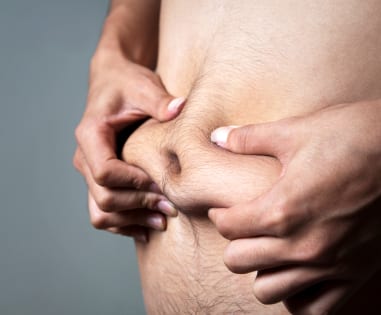 Visceral Abdominal Fat Accumulation: ‘The Big Belly Syndrome’
Visceral Abdominal Fat Accumulation: ‘The Big Belly Syndrome’
Excess fat localized to the abdominal area is without question the most dangerous form of fat accumulation with regards to potential negative health outcomes.[6] Visceral abdominal fat increases with age regardless of gender in both lean and overweight individuals [9] with many people of lower body weights not realizing their potentially problematic fat deposits since they mistakenly believe that their lower body weight is somehow an insulation against obesity related health risks. Men on average tend to have more visceral abdominal fat than women and those who are obese tend to have more visceral fat than those who are on the leaner side. Studies suggest that genetics play a significant factor in how much visceral abdominal fat you store[10] and women with high cortisol levels also tend to have higher levels of this form of fat.
Differences in Fat Storage & Weight Loss Between Women & Men
Men are often perceived as having an easier time losing weight and from a strictly numerical frame of reference there is some truth to this idea. Lean fat free muscle mass is responsible for the lion share of calories burned throughout the course of the day and men naturally have higher levels of muscle mass than their female counterparts.[19,20] Male patterns of excessive body fat distribution (android obesity) are usually different from female patterns (gynoid obesity), which is more or less self-evident. What isn’t as obvious is that differences in hormones, hormonal receptors, blood flow and the way fat tissue changes can create very distinct differences in both where and how quickly women lose fat when compared to men. One well controlled study compared a group of men and women who underwent a six month training program of both aerobic and resistance type exercises to determine gender based variance in increasing lean muscle mass and decreasing fat stores. Unlike many other studies, this research project employed both X ray and magnetic resonance imaging (MRI) to assess changes in body mass. Changes that give us some clear insight into the differences between the genders in this respect.

Rate Of Fat Loss In The Arms & Legs Is Determined By Gender
.
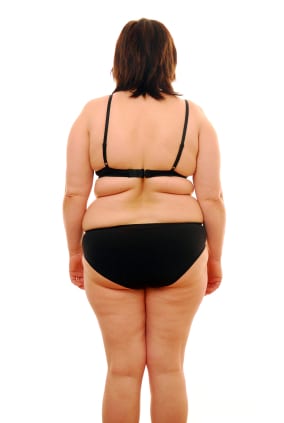
The study found that on average, the women had less lean muscle mass in their arms than the men both before and after the 24 week training period, which is by no means news to us, however what is compelling is that the women lost 31% of their fat mass in their arms but with no corresponding increase in lean muscle mass.[21] Nevertheless, women in the study gained an average increase of lean muscle mass of 5.5% in their legs with no corresponding decrease in fat in their legs.[21] The lack of fat mobilization in the lower body among women in the study is an incredibly important finding, and it corresponds to the countless experiences among women that losing fat in the lower body is a bit of an uphill battle on a rather slippery slope. In the study, female participants had an average of 18 lbs of body fat in their legs- a figure representing 34% (about one third) of their total fat stores. Yet no reductions in fat tissue were detected in the X ray or MRI scans. It should be noted that during the training period the women also lost 12% of their fat deposits in the truncal areas but without any increase in lean muscle tissue in those regions as well.
My own experience preparing for drug free bodybuilding competitions and coaching many over the years in preparation for drug free physique competitions and photo-shoots in is supported by several studies that conclude that fat in the legs is by nature resistant to being mobilized- regardless of gender. [20,22,23] An attribute that appears to be far more pronounced in women than in men since they tend to store significantly more of their total body fat in the lower body region (gynoid obesity) while men have comparatively less adipose tissue in their legs to begin with (android obesity). Why is it so hard to lose fat in your legs? We don’t know for certain, but researchers attribute the resistance of femoral fat tissue to several factors including localized blood flow, nervous system stimulation and fat utilization responses to stimulation from the endocrine system.[20,22,26,27]
Fat Loss Mobilization Patterns- Where Goes Down First
Another study evaluating gender specific fat loss observed the body mass changes in male and female U.S. Army Rangers during caloric energy deficit led researchers to define the following patterns of weight loss among for men and women:
Men lose body fat in the following hierarchical order- abdominal/trunk region- then in the arms and lastly in the leg and lower body region.[20, 21,24,25]
Women lose body fat in the following order- arms, truncal/abdominal area and finally in the legs. [20, 21,24,25]
Before training, the women had relative fat percentages in their legs that were similar to that of the men in the study, but after the training period women had relatively higher levels of fat in their legs compared to men. Gender based differences in fat mobilization are attributed to complex interactions between localized adipocyte receptors and differences in concentrations of testosterone and estradiol. Some interesting data emerged involving fat loss in the upper arm region among females as those with the highest percentages of total body fat also lost the most fat in their arms when compared to those with the lowest percentages of total body fat. Women tend to have the greatest regional percentage of fat in their arms[28] and in the Army Ranger study even though the women were able to reduce the fat in their arms, final arm adiposity was still on average far greater than the male comparison group.[24,25]
This study, however was designed to increase functional ability of the Rangers and so increasing lean muscle mass was not the expressed goal per se. Women in the study also did not perform exercises designed to isolate and target the biceps and triceps muscles- however other studies (and personal experience working with female athletes) support the fact that women can indeed increase the size of the muscles in their arms by 20% or more when engaged in targeted [29,30] training programs where hypertrophy is indeed the goal. Studies that also highlights the reality that without the use of external androgens (eg. anabolic steroids) the average woman training with weights at high intensities is not able to build upper arm muscle mass at levels comparable to that of men engaged in similar training programs. (See my article Should Women Lift Weights Like Men) Compared to their male counterparts, the women in the study had a lower percentage of lean muscle mass in their arms both before and after training. This lower muscle mass distribution goes a long way in explaining (in part) the differences between the sexes in terms of variations in upper body strength and power generation.[20] The findings from such studies underline the importance of focusing on regional and not whole body changes in body fat as a measure of continued success during any weight loss program, since for both men and women, measuring only total body fat losses won’t tell the full story. [20] Too often we use the wrong parameters to mark our success when it comes to weight loss- we look at our trouble spots (which as we see is the last place to look as they will often be the last parts of your body to lose fat). We look to the numbers on the scale, numbers that tell us little in the way of whether weight lost was body fat, water weight or muscle mass and are for the most part misleading at best. And finally we look to the conventional gold standard of skinfold body fat testings for measurements and changes in body fat- a tool often used by personal trainers and weight loss related professionals as the de facto barometer of progress or lack of it thereof. That being said, even skinfold testing may lead to some degree of frustration as they cannot always detect fat losses certain parts of your body- which may lead you to believe that you are not making progress while other parts of your body show tangible signs of fat loss. Losses that cannot be detected with skinfold calipers.
Why People Store Fat In Different Parts Of Their Body: Genetics And Fat Distribution
Some are blessed with naturally low body fat in the abdominal area and can have a six pack without ever doing any form of exercise.
As much as we may hate to think that some aspects of our reality are predetermined, the reality is that the placement of our fat stores is a direct consequence of who are parents were. Research shows conclusively that genetics plays a large role in why some people store more fat in certain parts of the body regardless of whether they are overweight or not. [3, 16] In my experience working with everyone from stay at home moms and corporate types trying to lose weight to bodybuilders and fitness models preparing for competitions and or photoshoots, I have seen some individuals who were noticeably overweight but who still had a pronounced a six pack, while others dieted down to single digit body fat percentages and could barely see their abs. The genetic nature of such discrepancies in body fat storage was highlighted in a several studies involving male twins that found strong familiar resemblances in terms of body fat distribution among brothers. [17, 18]
Being Overweight Does Not Necessarily Mean Greater Health Risks
In addition to the four phenotypes mentioned above, research has revealed the existence of a rather paradoxical subgroup of individuals who are overweight, have excessive amounts of body fat and yet have none of the markers for increased risk of cardiovascular, disease, diabetes or any other metabolic syndrome related to obesity.[4] On the contrary, these individuals have an overall better metabolic profile than normal weight individuals with metabolic syndrome, with better cholesterol profiles, lower cardiovascular risk scores, less estimated liver fat and less incidences of previously undetected diabetes. [4] A Finnish study found the prevalence of healthy but obese individuals was higher among women than among men (16.4% versus 49.2%) and that 10% of obese individuals fell into the category of being metabolically healthy in spite of their weight.
Do Some People Put On Fat Easier Than Others?
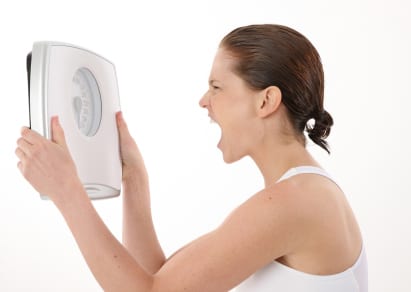
Many individuals seem to struggle against growing waistlines and excessive accumulation of fat in unwanted areas while others appear to be relatively well protected against putting on excess fat, and a study involving twins shed some light on just how much of a role genetics can play in where and how easily individuals gain adipose tissue. For the experiment 112 pairs of male monozygotic (identical) twins were given a diet consisting of 1,000 kcal per day over how many calories their bodies needed to maintain their starting body weight, 6 days a week for 100 days without additional exercise.[16] Of course with such a persistently high calorie intake they did gained significant amounts of body fat- but there were significant variations in both how much weight was gained and where the excess body fat was stored among the sets of twins. But with strong similarities reported within pairs.[5] For example there was three times more of a difference between pairs than within pairs for gains in body weight, body fat, and lean muscle mass and when differences in where fat was deposited on the body there was six times more variance between pairs than within peers.
All in all there were very strong similarities among identical twins in terms of their increases in trunk fat and visceral abdominal fat. These findings go a long way in demonstrating that some individuals are more at risk than others to gain fat when calorie intake is set at the same relative level for everyone and when subjects are confined to a sedentary lifestyle.[5] What is most striking is that while genetics do influence total body fat content, the effect of inherited traits is even more pronounced in terms of where you will store fat on your body. Understanding this leads us to look critically at our family members as a possible template for our own potential weight gain, but it must be noted that our genetics are what determines where we start in terms of body fat- not where we end. As a regime of proper nutrition and exercise has been shown time and time again to be able to overcome even the most stubborn of fat deposits. However it does take time, and for some it will take longer than others, but at the end of the day it isn’t about how long it took you to reach your destination, it’s that you made it! Thanks for reading and if you need help reducing fat around your abdominal area, be sure to get a free copy of my ebook below on the role of exercise in reducing body fat.
High Intensity Bodyweight Training: Ballistic Pushups & Dips!
This was a tough one!
Starts out with ballistic push ups (like clap pushups but without the clap as my wrist is still not 100%) nonstop for 20 reps, then all out on dips for 10 reps.
To say it was painful would be an understatement, but you just have to push through and keep on going.
Still training, hope you are too and as always, Excelsior!!! #naturallyintense
#hometraining #homeworkout #homeworkout #highintensitytraining #naturalbodybuilder #naturalbodybuilding #fitover40 #naturalbodybuildingvideos #chestday #chesttraining #naturalbodybuildingtips #pushups #dips #bodyweighttraining #highintensitytrainingtips #drugfreebodybuilding #calesthenics
Kevin's Unconventional Biceps Training- 3-6 Minutes a Week!
In this video I go over my biceps training using the Naturally Intense High Intensity Training protocols that helped me go from having arms measuring 11.5 to 12 inches to 18 inches drug free!
It's an unconventional approach for certain, but it's one that's helped my arms grow and the hundreds of men and women I have trained over the past 30 plus years.
Now, my success isn't due to being genetically gifted, as it took me the better part of 11 years to get my arms up to those measurements.
Which is significant as it works and been been proven time and time again to work for the average man or woman trying to grow their arms without drugs.
It's my hope that these high intensity training protocols can help you as much as they helped me!
Click on my bio link to see the full video on my YouTube channel and thanks as always for taking the time to look at my work!!! Excelsior!!! #naturallyintense
#highintensitytraining #naturalbodybuilder #naturalbodybuilding #fitover40 #naturalbodybuildingvideos #armworkout #bicepsworkout #naturalbodybuildingtips #biceps #armtraining #highintensitytrainingtips #drugfreebodybuilding #barbellcurls
At the Lancaster Classic Day 2 Elimination Rounds Against European Champion, and World Record Holder Leo Pettersen @leo_barebow_archer
I don't talk much about it but I'm also a competitive barebow archer (surprise!) and last Saturday I had the honor of making it to Day 2 at the Lancaster Archery Classic in the Barebow Division, as I made the top 64 out of 267 competitors and had a chance to shoot with some of the greatest barebow shooters on the planet!
I didn't make it past Leo, but it was a real rush to be there and a huge thanks to my coach, Joe MyGlyn @prolinearchery for helping me get there.
Thanks as well to my good friend @sean_chan33 for all of his help from the very start, to my line buddy Aaron Shea for taking the shot and showing up to support!
My thanks as well to rob_kaufhold for putting on and promoting one of the best archery tournaments on earth!
Thanks also to to everyone who took the time to send a supporting word and I am looking forward to next year!!! #naturallyintense #barebow
#lancasterclassic #lancasterarcheryclassic2024 #lancasterarchery #archery #fitover40 #barebowrecurve #targetarchery
Dumbo, Brooklyn circa 2004
This shot was taken as part of the promotion for my Naturally Intense DVD and was about a year after my last bodybuilding competition.
It was a grueling photoshoot.
We started at about 10 am and finished around 4pm and I was completely spent, but the more we shot the sharper I looked, so we kept on going.
It's nice to look back from time to time and as tired as I was, we all had a blast!
My thanks to @stephanie_corne_artwork, @https://pulse.ly/itgnag2dec and @ftaz1 for taking the shots!!!
Thanks for watching and as always, Excelsior!!! #naturallyintense
#naturalbodybuilder #naturalbodybuilding #throwback #fifthavenuegym #5thavenuegym #drugfreebodybuilding #naturalbodybuildinglifestyle #gymlife #gymmotivation #naturalbodybuildingmotivation #bodybuilding #blackandwhite #instablackandwhite #bnw
Can You Build An Impressive Physique Training Only At Home?
Absolutely!
I stopped training in commercial gyms as of March 2020 and have been training at home ever since.
Initially I was admittedly worried that I might lose some of my gains or not make as much progress, but that certainly wasn't the case.
I've consistently continued to improve with my high intensity workouts and muscles have no idea where they are training.
As long as the criteria of adequate intensity and overload are met, there will be an adaptive response and your muscles will get bigger and stronger.
So don't worry at all about where you train, focus instead of what will be the best way for you to always be training!
Thanks for watching and as always, Excelsior!!! #naturallyintense
Kevin's Three Day Training Spilt!
For the past 33 years I have trained three times a week with Naturally Intense High Intensity Training workouts lasting 10, 15 to 20 minutes max.
It's a training split tried and testes not only in it's helping me realize my goal of becoming a successful natural bodybuilder, but it's also helped hundreds of men and women over the past three decades.
I have tested just about every possible training split imaginable and for this particular style of high intensity training, this particular grouping consistently yields fantastic results.
I hope it helps you as much as it's helped me over the years and thanks so much for taking the time to look at my work.
Keep training hard and Excelsior!!! #naturallyintense
Excelsior!!! #naturallyintense
#trainingsplit #3daytrainingsplit #threedaytrainingsplit #naturalbodybuilding #naturalbodybuilder #naturalbodybuildingvideo #naturalbodybuildingmotivation #naturalbodybuildingtips #drugfreebodybuilding #bodybuilding #highintensitytraining #highintensitytrainingtips
405 Stiff Leg Deadlift for 7 Reps! High Intensity Training.
First leg workout of the year and already pushing it!
I haven't done a stiff leg deadlift over 315lbs for about 3 years at this point, and I did my last set with 315lbs and comfortably got to 10 reps and decided I had far too much gas left in the tank and that I should go up in weight.
So I did.
I figured I might get a solid 6 reps in, but I made it to 7 and I think I could have gone on to get a full 10 reps BUT that's when good judgement prevailed.
As a bodybuilder having not trained this heavy for so many years, the shock of this much weight would be more than enough to stimulate muscle growth, and doing more reps wouldn't yield any greater returns, only increase the likelihood of injury.
It's not about the numbers, it's about training to a point where you achieve your goal, and it's important to have a goal in mind as a bodybuilder based on increasing muscle mass rather than hitting a particular number.
Besides, if in my 20's I never did more than 405lbs on a stiff leg deadlift, it doesn't make any sense going heavier than when I am almost 50!
Could I deadlift more at this point?
Absolutely but just because you can doesn't mean you should!
So keep those weights in a good working range, keep it safe and as always Excelsior!!! #naturallyintense
#hometraining #homeworkout #homeworkout #roguerack #highintensitytraining #naturalbodybuilder #naturalbodybuilding #fitover40 #naturalbodybuildingvideos #backworkout #naturalbodybuildingtips #backtraining #highintensitytrainingtips #drugfreebodybuilding #fitoverforty #deadlift
Turning 50 in a few months...
Not much of a big deal for me as I still feel pretty much the same but I hope that my example helps show what can be done with a lifetime commitment to eating well and training consistently!
Thanks for coming along on the journey and as always, Excelsior!!! #naturallyintense
#naturalbodybuilder #naturalbodybuilding #healthylifestyle #fitover40 #drugfreebodybuilding #naturalbodybuildingmotivation #natty #fitness
Please note that all material is copyrighted and DMCA Protected and can be reprinted only with the expressed authorization of the author.
Featured everywhere from the Wall Street Journal to CBS News, Kevin Richardson’s Naturally Intense High Intensity Training have helped hundreds lose weight and transform their bodies with his 10 Minute Workouts. One of the top natural bodybuilders of his time, Kevin is also the international fitness consultant for UNICEF and one of the most sought after personal trainers in New York City. Click to learn more about his personal training NYC
Related Articles:
How Long Does It Take To Get Muscle Definition?
Does Weight Training Reduce Breast Size?
Does Race Play A Role In Weight Loss?
Dealing With Loose Skin After Weight Loss
References for Why People Store Fat In Different Parts of The Body
1. WHO Report of a WHO Consultation : Geneva World. Health Organization 2000
2. Selected health conditions and risk factors: United States, selected years 1988–1994 through 2009–2010. Center for Disease Control & Prevention 2011
3. Bouchard, C. Inheritance of human fat distribution. In Bouchard, C. and Johnson, F.E. (eds),Fat Distribution during Growth and Later Health Outcomes. Alan R.Liss, New York 1988
4. Pajunen P, Kotronen A, Korpi-Hyovalti E, Keinanen-Kiukaanniemi S, Oska H, Niskan L, Saaristo T, Saltevo JT, Sunduvall J, Vanhala M, Uusitupa M, Peltonen M. Metabolically healthy and unhealthy obesity phenotypes in the general population: the Finnish FIN-D2D Survey BMC Public Health 2011
5. Bouchard C. Genetic determinants of regional fat distribution. Human Reproduction 1997
6. Nindl BC, Harman EA, Marx JO, Gotshalk LA, Frykman PN, Lammi E, Palmer C, Kraemer WJ. Regional body composition changes in women after 6 months of periodized physical training. J Appl Physiol 2000
7. StevensJ, Cai J, Parmuk ER, Wiliamson DF, Thun MU, Wood JL. The effect of age on the association between body mass index and mortality. N Eng J Med 1988
8. Brook RD, Bard RL, Rubenfire M, Ridker PM, Rajagopalan S. Usefullness of visceral obesity & waist hip ratio) in predicting endothelial function in healthy overweight adults. Am J Cardiol 2001
9. Enzi G. Gasparo M, Biondetti PRR et al. Subcutaneous and visceral fat distribution according to sex, age and overweight, evaluated by computed tomography. AM J Clin Ntr 1986
10 Perusse L, Despres JP, Lemieux S et al. Familial aggregation of abdominal visceral fat level: results from the Quebec Family Study. Metabolism 1996
11. Flegal KM. Higher Levels of Obesity Associated With Increased Risk of Death; Being Overweight Associated With Lower Risk of Death JAMA 2009
12. Adam TC, Epel ES. Stress eating and the reward system. Physio & Behaviour 2007
13. Epel ES, McEwen B, Seeman T, Matthews K, Castellazzo G, Brownell KD, et al. Stress and body shape: stress-induced cortisol secretion is consistently greater among women with central fat. Psychosom Med2000
14. Marin P, Darin N, Amemiya T, Andersson B, Jern S, Bjorntorp P. Cortisol secretion in relation to body fat distribution in obese premenopausal women. Metabolism 1992
15. Duclos M, Marquez Pereira P, Barat P, Gatta B, Roger P. Increased cortisol bioavailability, abdominal obesity, and the metabolic syndrome in obese women. Obes Res 2005
16.Bouchard, C. Variation in human body fat: The contribution of the genotype. In Bray, G., Ricquier, D. and Spiegelman, B. (eds), Obesity: Towards a Molecular Approach. Alan R.Liss, New York 1990
17. Donahue, R.P., Prineas, R.J., Gomez, O. and Hong, C.P. Familial resemblance of body fat distribution: the Minneapolis Children’s blood pressure study. Int. J. Obes.1992
18. Selby, J.V., Newman, B., Quesenberry Jr, C.P. et al. Evidence of genetic influence on central body fat in middle-aged twins. Hum. Biol 1989
